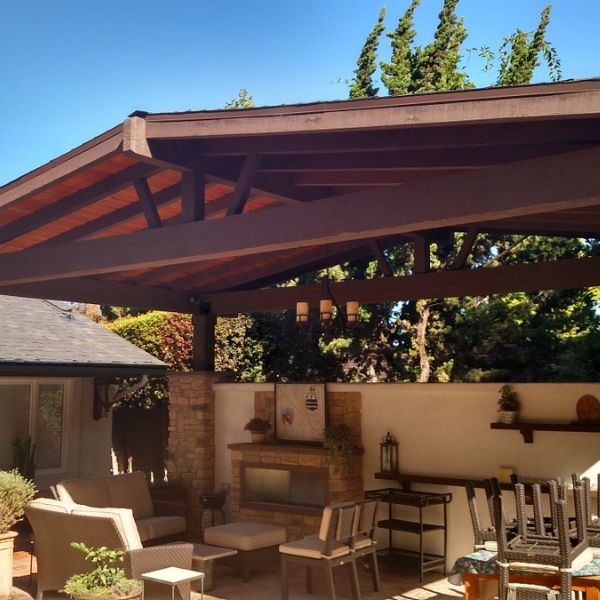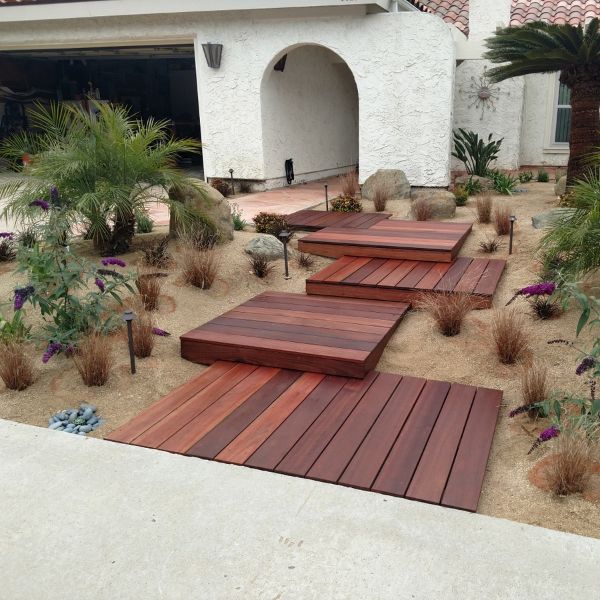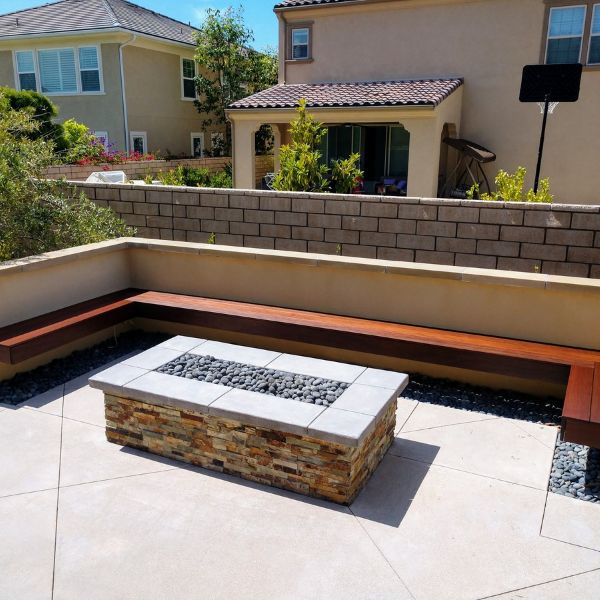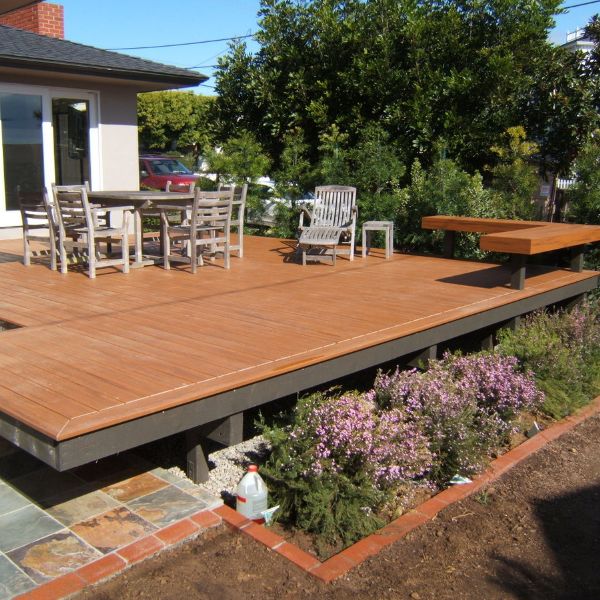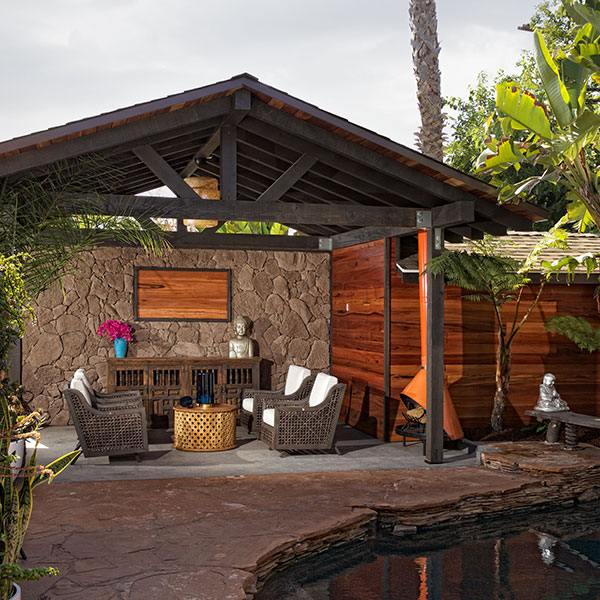Redesign Your Backyard With Wilson Woodscape’s Ground-Level Decks
When crafting your dream outdoor living space, consider the allure of a deck on grade. At Wilson Woodscape, San Diego landscape contractor Jeff Wilson can create seamlessly accessible, natural-looking ground-level decks. Whether you seek a simple, functional area for al fresco dining or a cozy retreat for relaxation and entertainment, a deck on grade could be the perfect addition.
These decks offer unparalleled versatility, cost-effectiveness, and ease of construction, making them an irresistible choice for homeowners. To get started, call Jeff today at 619-838-1398.
What Is a Deck on Grade?
A deck on grade, also known as a ground-level deck or floating deck, is built directly on the ground rather than elevated, eliminating the need for posts, stairs, or railings. This design offers flexibility in placement and protects against moisture-related issues like mold and rot.
Compared to raised decks, ground-level decks seamlessly connect with your outdoor spaces, creating a welcoming and functional backyard. Our San Diego landscaping contractor can craft unique ground-level decks using various materials, from pressure-treated lumber to composite and PVC decking. These decks are tailored to your preferences, featuring custom elements like built-in seating, fire pits, and lighting.
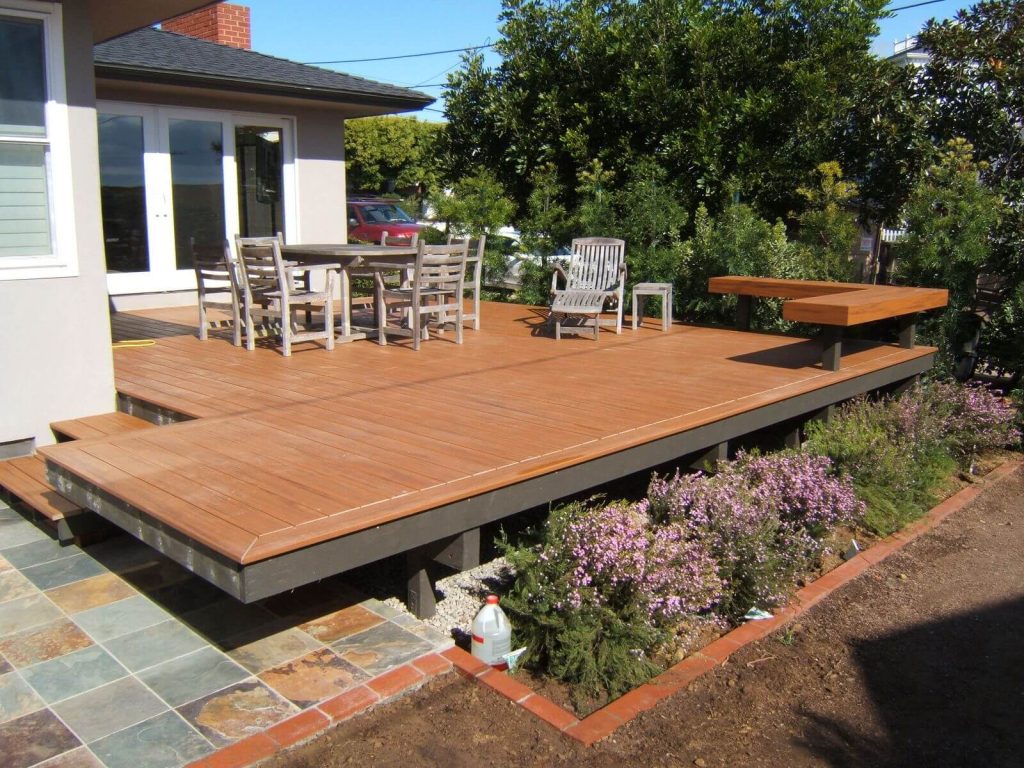
Why Choose Wilson Woodscape for Your Deck on Grade
If you’re thinking about constructing a ground-level deck, Wilson Woodscape is an exceptional choice due to our vast experience, commitment to excellent craftsmanship, and unique designs.
With 40 years of construction experience and 25 years of landscape experience, Jeff Wilson can design unique concepts using custom ironwork, woodwork, concrete work, and more to elevate your outdoor space. Choosing Wilson Woodscape means investing not just in an attractive deck on grade, but in innovative and superior quality as well.
The Benefits of a Deck on Grade
Building a deck on grade can offer several advantages compared to traditional raised decks. Benefits include:
- Easier Access: Ground-level decks are more accessible than raised decks as they don’t require stairs or ramps for access, making them ideal for households with individuals who have mobility challenges.
- Natural Aesthetic: They seamlessly blend with the surrounding landscape since they’re closer to the ground, offering a more natural and rustic look in your backyard.
- No Permits Needed: In many areas, decks on grade often don’t require permits or inspections, making them a simpler and faster option than raised decks. However, it’s crucial to verify local building regulations and codes.
- Versatility: Ground-level decks can serve various purposes, from outdoor dining and entertaining to relaxation and enjoying the outdoors.
- Cost-Efficiency: They require fewer materials and labor, leading to cost savings compared to elevated decks.
- Quick Construction: The construction process is swift and straightforward with minimal ground contact, ensuring efficient completion.
- Flexible Location: Ground-level decks provide flexibility in choosing the location, allowing for the creation of beautiful outdoor living spaces in areas where elevated decks may not be feasible.
- Visual Appeal and Structural Integrity: The installation process, including platform deck joists, rim joists, and deck board placement, is typically done perpendicular to the joists. This results in a visually pleasing and structurally sound surface that enhances your home’s outdoor aesthetics using high-quality deck boards and joist hangers.
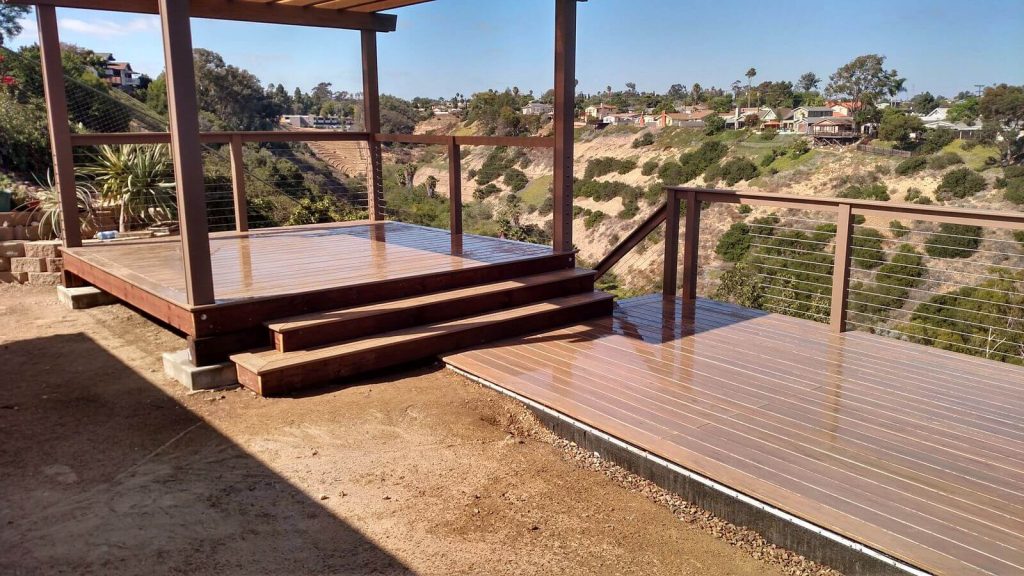
Deck on Grade Materials
Choosing appropriate materials for your deck on grade is paramount for its durability and longevity. Some popular options include:
- Cedar
- Redwood
- Pressure-treated wood
- Tropical hardwoods like ipe and cumaru
- Composite decking materials
Alternative Materials
If you’re looking for something beyond traditional wood or composite decking, there are several alternative materials available for a deck on grade, including:
- Aluminum decking
- Bamboo decking
- Rubber paver tiles
- Interlocking deck tiles
The Deck on Grade Building Process
Planning and Design
One of the first things to consider when building a deck on grade is the location and the type of foundation you’ll need. Since the deck is on the ground, it’s essential to ensure the foundation is stable and won’t shift over time. Some of the most popular foundation options for decks on grade include concrete piers, deck blocks, and helical piles.
Once you have chosen the foundation, the next step is to plan the layout and size. The deck should complement the surrounding landscape, and our contractor will account for any natural features, such as trees or slopes. You’ll also need to consider the intended use of the deck, such as whether you’ll use it primarily for dining, lounging, or entertaining.
Foundation and Framing
After finalizing the layout, the next step is to prepare the ground for the foundation. This preparation may involve removing any sod or vegetation, grading it to ensure proper drainage, and installing a weed barrier to prevent unwanted growth through the deck boards.
Building the foundation involves placing the concrete piers, deck blocks, or helical piles in the proper locations and ensuring they’re level and secure. With the foundation in place, it’s time to start building the deck frame above it, using high-quality materials to avoid rotting wood or rusting hardware.
Building and Finalizing
After the frame is complete, installation of the deck boards can begin. The boards are installed perpendicularly to the frame and spaced apart for proper drainage. We also leave a small gap between the boards to allow for expansion and contraction due to changes in temperature and moisture.
The last step is adding any finishing touches, such as railings, stairs, and lighting. These elements not only add to the functionality of the deck but also enhance its aesthetic appeal.
Deck on Grade Design Ideas
If you’re unsure how you want your deck on grade to look, consider any of the following design ideas:
- Built-In Seating: Integrating built-in seating into your deck on grade design not only enhances functionality and comfort but also provides additional storage space. Whether through benches, planters, or freestanding options, this addition offers both convenience and style to your outdoor living area.
- Planters and Landscaping: Incorporating raised beds, planter boxes, and containers filled with various plants and shrubs complements your home’s style and color palette. This addition not only enhances the aesthetic of your deck on grade but also creates a tranquil, natural atmosphere, offering an extra layer of privacy and contributing to a healthier outdoor environment.
- Lighting and Accessories: Adding proper lighting and accessories to your deck design can significantly improve its ambiance and usability, especially during the evening. Consider features like solar-powered lights, LED lights, string lights, post lights, and landscape lighting to create a warm and inviting atmosphere for your outdoor space.
Deck on Grade Maintenance
Taking care of a deck on grade can help ensure it lasts for years and remains safe. Here are some tips on how to take care of a deck on grade:
- Regular Cleaning: Decks on grade are prone to collecting dirt, debris, and moisture, which can lead to the growth of mold, mildew, and algae. Regularly clean your deck by sweeping debris and using a garden hose or pressure washer to remove dirt or stains. Be careful not to use too much pressure when using a pressure washer, as it can damage the wood.
- Seal or Stain the Deck: Sealing or staining your deck can help protect it from moisture and UV rays, which can cause the wood to warp, crack, or fade. A sealant or stain also helps enhance the natural beauty of the wood and prevent it from splintering.
- Repair Damaged Boards: Regularly inspect your deck for any damaged boards, loose screws or nails, or other signs of wear and tear. Replace any damaged boards or fasteners and tighten any loose screws or nails.
- Protect the Deck from Moisture: Decks on grade are especially susceptible to moisture, which can cause the wood to rot and decay. To protect your deck, make sure the area beneath is well-ventilated with no standing water. You may consider installing a drainage system to redirect water away from the deck.
- Prevent Mildew Growth: Mildew growth is a common problem with decks on grade. To prevent mildew, keep your deck properly cleaned and maintain good air circulation around the deck. You can also use a mildew-resistant cleaning solution to help prevent mildew.
With regular maintenance and care, your deck can provide a comfortable and inviting outdoor space for many years.
Frequently Asked Questions
You should clean your deck on grade at least once a year, but it may need cleaning more often if it’s in a shaded area or prone to collecting debris. Use a broom or leaf blower to remove any debris, and then use a pressure washer or hose to wash the deck. Be sure to let the deck dry completely before using it again.
The permit requirements for a deck on grade vary depending on your location and the size of the deck. In general, if your deck is larger than 200 square feet, you may need a permit. Check with your local building department to find out what the requirements are in your area.
To prevent mildew growth on your deck, ensure it’s properly cleaned and that there’s good air circulation around and under the deck. You can also use a mildew-resistant cleaning solution to help prevent the growth of mildew. If mildew does start to grow on your deck, you can use a mixture of water and bleach to remove it.
The most common materials used for decks on grade are pressure-treated lumber, composite decking, and concrete. Pressure-treated lumber is affordable and easy to work with but requires regular maintenance. Composite decking is low-maintenance and durable but can be more expensive than wood. Many different manufacturers have venting requirements for their warranties.
Fall in Love With Your Yard With Wilson Woodscape
Wilson Woodscape can build a deck on a grade that will become a fantastic addition to any outdoor space. Whether you’re looking to create a transition between indoor and outdoor spaces or simply want a place to relax and enjoy the outdoors, a deck on grade is an affordable and practical option. Contact us today at 619-838-1398 to learn more about building your dream deck in San Diego.

